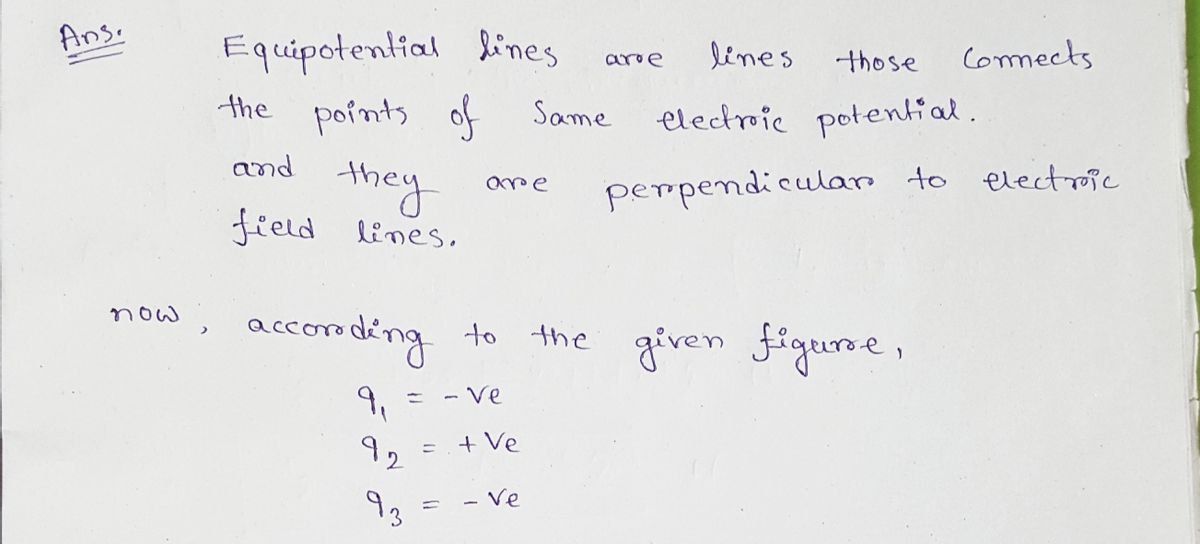192 93
Q: The equipotential lines in a region of electric field are shown in the diagram below. For each path…
A: Work done,
Q: For each path indicated below, what is the work done by the electric field in moving a charge q =…
A: (a) From A to B WAB=qVA-VB=q-V0--2V0=-qV0=-1.5×10-7 C230 V=3.45×10-5 J (b) From A to C…
Q: The direction of the electric field at point b is closest to which direction?
A:
Q: Don't use chatgpt will upvote
A: due to less space i miss *10-12 in the cordinates of all points of the graph. thank you
Q: Why must electric-field lines be perpendicular to equipotential surfaces?
A:
Q: The equipotential lines in a region of electric field are shown in the diagram below. For each path…
A:
Q: sketch the equipotential lines near a point charge +q. Indicate the direction increasing…
A:
Q: The figure below shows several equipotential lines each labeled by its potential in volts. The…
A: The electric field is defined as the rate of decrease in potential with respect to the distance.…
Q: The figure shows a set of equipotential surfaces by the dashed lines. Note that the diagram is not…
A: CONCEPT: Electric field should be perpendicular to the equipotential surface. Direction of electric…
Q: The potential in a region is V = axy, where a is a constant. (a) Determine the electric field in…
A: (a) The electric potential function is as follows, The components of electric field is calculated…
Q: The figure below shows the equipotential lines due to a dipole placed on the x axis. The voltage…
A: In this problem, the equi-potential lines are given. so, by using these lines, the potential…
Q: Consider a region in space where a uniform electric field E = 6590 N/C points in the negative I…
A: Given information: Here, E is the electric field. V1 and V2 are the potentials at the points x1…
Q: 2: If there are two equipotential surfaces separated by a distance of 25 centimeters as shown. Which…
A: In the figure, the electric field lines are the same, and they point in the same direction. Hence,…
Q: 296.2 cm 30.1 V 10,0 V 20.0 V. 5.0 V
A: Particle starts at a 5 V and ends at 5 V .
Q: How does the space between the equipotential lines change as you move them away from the load? Why?
A: Equipotential lines are lines where potential at all points. Equipotential lines for a point charge…
Q: The equipotential lines in a region of electric field are shown in the diagram below. For each path…
A: Given data The magnitude of the charge is q = 5.3 x 10-7 C The magnitude of the potential difference…
Q: If an electron started at rest at point b, how fast would it be moving when it reaches point i?
A:
Q: How much work is done to move a charge of 1.5 meters using 10 Newtons od force across an…
A:
Q: The voltage difference between two neighbouring equipotentials is 250 V and are separated by 0.5 mm.…
A: The voltage difference between two different equipotentials…
Q: A parallel plate capacitor is charged up by a battery. The battery is then disconnected, but the…
A: A capacitor is a device that stores electrical energy in an electric field. It is made up of two…
Q: The electric field and potential field produced by three-point charges is shown in the figure below.…
A: From the given diagram:VA=8.7 VVB=-7.0 Vq=2.0 μC


Step by step
Solved in 2 steps with 2 images

- (a) Sketch the equipotential lines near a point charge + q. Indicate the direction of increasing potential. (b) Do the same for a point charge – 3 q .Can two fields or equipotential lines be crossed? Is this possible according to the connections of the lines?Can you draw an equipotential surface through a positionwhere the electric field vanishes?
- The equipotential lines in a region of electric field are shown in the diagram below. For each path indicated below, what is the work done by the electric field in moving a charge q = +4.8 x 10-7 C along that path? Here Vo = +100 V. 3Vo D 2Vo Vo - Vo A OV -2Vo -3Vo (a) from A to B WAB = (b) from A to C WAC = (c) from A to D WAD = (d) from D to C WDc =The figure below shows the equipotential lines due to a dipole placed on the x axis. The voltage values are shown on each line. What is the potential difference in Volts between the points A and B (ΔV=VB−VA) shown with green dots.Suppose you have a point charge of 4.61 microColoumbs. How far apart are the 851 V and 279 V equipotentials?
- The equipotential lines in a region of electric field are shown in the diagram below. For each path indicated below, what is the work done by the electric field in moving a charge q = +4.1 × 10-7 C along that path? Here Vo = +140 V. -Vo -2Vo (a) from A to B W = AB = -3Vo (b) from A to C WAC (c) from A to D WAD = (d) from D to C WDC J J J A B D 3Vo 2V0 Vo OVThe figure below shows equipotential surfaces (cross-section view in the x-y plane). In which of the points is might the electric field given by: E = (10.5i - 3.8j) v/m12